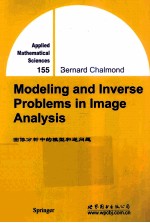
- 作 者:(法)查蒙德著
- 出 版 社:北京/西安:世界图书出版公司
- 出版年份:2014
- ISBN:9787510070198
- 标注页数:312 页
- PDF页数:336 页
请阅读订购服务说明与试读!
订购服务说明
1、本站所有的书默认都是PDF格式,该格式图书只能阅读和打印,不能再次编辑。
2、除分上下册或者多册的情况下,一般PDF页数一定要大于标注页数才建议下单购买。【本资源336 ≥312页】
图书下载及付费说明
1、所有的电子图书为PDF格式,支持电脑、手机、平板等各类电子设备阅读;可以任意拷贝文件到不同的阅读设备里进行阅读。
2、电子图书在提交订单后一般半小时内处理完成,最晚48小时内处理完成。(非工作日购买会延迟)
3、所有的电子图书都是原书直接扫描方式制作而成。
1 Introduction 1
1.1 About Modeling 3
1.1.1 Bayesian Approach 3
1.1.2 Inverse Problem 8
1.1.3 Energy-Based Formulation 10
1.1.4 Models 11
1.2 Structure of the Book 14
Ⅰ Spline Models 21
2 Nonparametric Spline Models 23
2.1 Definition 23
2.2 Optimization 26
2.2.1 Bending Spline 26
2.2.2 Spline Under Tension 28
2.2.3 Robustness 31
2.3 Bayesian Interpretation 34
2.4 Choice of Regularization Parameter 36
2.5 Approximation Using a Surface 39
2.5.1 L-Spline Surface 40
2.5.2 Quadratic Energy 43
2.5.3 Finite Element Optimization 46
3 Parametric Spline Models 51
3.1 Representation on a Basis of B-Splines 51
3.1.1 Approximation Spline 53
3.1.2 Construction of B-Splines 54
3.2 Extensions 57
3.2.1 Multidimensional Case 57
3.2.2 Heteroscedasticity 62
3.3 High-Dimensional Splines 67
3.3.1 Revealing Directions 68
3.3.2 Projection Pursuit Regression 70
4 Auto-Associative Models 75
4.1 Analysis of Multidimensional Data 75
4.1.1 A Classical Approach 76
4.1.2 Toward an Alternative Approach 80
4.2 Auto-Associative Composite Models 82
4.2.1 Model and Algorithm 82
4.2.2 Properties 84
4.3 Projection Pursuit and Spline Smoothing 86
4.3.1 Proiection Index 87
4.3.2 Spline Smoothing 90
4.4 Illustration 93
Ⅱ Markov Models 97
5 Fundamental Aspects 99
5.1 Definitions 99
5.1.1 Finite Markov Fields 100
5.1.2 Gibbs Fields 101
5.2 Markov-Gibbs Equivalence 103
5.3 Examples 106
5.3.1 Bending Energy 106
5.3.2 Bernoulli Energy 107
5.3.3 Gaussian Energy 108
5.4 Consistency Problem 109
6 Bayesian Estimation 113
6.1 Principle 113
6.2 Cost Functions 118
6.2.1 Cost Function Examples 119
6.2.2 Calculation Problems 121
7 Simulation and Optimization 123
7.1 Simulation 124
7.1.1 Homogeneous Markov Chain 124
7.1.2 Metropolis Dynamic 125
7.1.3 Simulated Gibbs Distribution 127
7.2 Stochastic Optimization 130
7.3 Probabilistic Aspects 134
7.4 Deterministic Optimization 138
7.4.1 ICM Algorithm 138
7.4.2 Relaxation Algorithms 141
8 Parameter Estimation 147
8.1 Complete Data 148
8.1.1 Maximum Likelihood 149
8.1.2 Maximum Pseudolikelihood 150
8.1.3 Logistic Estimation 153
8.2 Incomplete Data 156
8.2.1 Maximum Likelihood 157
8.2.2 Gibbsian EM Algorithm 161
8.2.3 Bayesian Calibration 170
Ⅲ Modeling in Action 175
9 Model-Building 177
9.1 Multiple Spline Approximation 177
9.1.1 Choice of Data and Image Characteristics 179
9.1.2 Definition of the Hidden Field 181
9.1.3 Building an Energy 183
9.2 Markov Modeling Methodology 185
9.2.1 Details for Implementation 185
10 Degradation in Imaging 189
10.1 Denoising 190
10.1.1 Models with Explicit Discontinuities 190
10.1.2 Models with Implicit Discontinuities 198
10.2 Deblurring 201
10.2.1 A Particularly Ill-Posed Problem 202
10.2.2 Model with Implicit Discontinuities 204
10.3 Scatter 205
10.3.1 Direct Problem 206
10.3.2 Inverse Problem 211
10.4 Sensitivity Functions and Image Fusion 216
10.4.1 A Restoration Problem 217
10.4.2 Transfer Function Estimation 221
10.4.3 Estimation of Stained Transfer Function 224
11 Detection of Filamentary Entities 227
11.1 Valley Detection Principle 228
11.1.1 Definitions 228
11.1.2 Bayes-Markov Formulation 230
11.2 Building the Prior Energy 231
11.2.1 Detection Term 231
11.2.2 Regularization Term 234
11.3 Optimization 236
11.4 Extension to the Case of an Image Pair 239
12 Reconstruction and Projections 243
12.1 Projection Model 243
12.1.1 Transmission Tomography 243
12.1.2 Emission Tomography 246
12.2 Regularized Reconstruction 247
12.2.1 Regularization with Explicit Discontinuities 248
12.2.2 Three-Dimensional Reconstruction 252
12.3 Reconstruction with a Single View 256
12.3.1 Generalized Cylinder 256
12.3.2 Training the Deformations 259
12.3.3 Reconstruction in the Presence of Occlusion 261
13 Matching 269
13.1 Template and Hidden Outline 270
13.1.1 Rigid Transformations 270
13.1.2 Spline Model of a Template 272
13.2 Elastic Deformations 276
13.2.1 Continuous Random Fields 276
13.2.2 Probabilistic Aspects 282
References 289
Author Index 301
Subject Index 305
